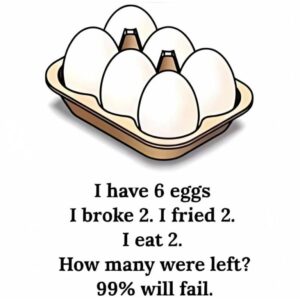Riddles are a fantastic way to engage our minds, enhance problem-solving skills, and challenge preconceived notions. At first glance, they often appear simple, yet their cleverly crafted wording can stump even the most logical thinkers. One classic example that has puzzled many is the popular brain teaser: “How many eggs are left?”

While this question seems like a straightforward math problem, its phrasing is deliberately designed to mislead, prompting many to second-guess their initial responses. Let’s take a closer look at this intriguing riddle, dissect it step by step, and uncover the reasoning behind the correct solution.
Understanding the Riddle
The riddle goes like this:
You have 6 eggs.
You break 2 eggs.
You cook 2 eggs.
You eat 2 eggs.
So, how many eggs are left?
At first glance, most people assume that each action involves separate eggs—2 eggs broken, 2 eggs cooked, and 2 eggs eaten. This assumption leads to the conclusion that all 6 eggs are used up. However, here’s the twist: the riddle never specifies that different eggs are involved in each step.
The Correct Answer: 4 Eggs Are Left
The right answer is that 4 eggs remain.
If this surprises you, you’re not alone. Many people overlook the key detail: the same 2 eggs are broken, cooked, and eaten, leaving the remaining 4 eggs untouched.
Let’s break it down further for clarity:
You start with 6 eggs.
Total: 6 whole eggs.
You break 2 eggs.
Two eggs are cracked, leaving 4 whole eggs untouched.
You cook 2 eggs.
The same 2 eggs that were broken are now cooked.
You eat 2 eggs.
The same 2 eggs that were broken and cooked are now eaten.
The critical point here is that all the actions—breaking, cooking, and eating—refer to the same 2 eggs. The other 4 eggs remain untouched and whole throughout the process.
Why the Riddle is So Misleading
This riddle is particularly tricky because it plays on our natural assumptions. When we hear “2 eggs broken,” “2 eggs cooked,” and “2 eggs eaten,” our brains often interpret these actions as referring to different eggs in each step.
However, the sequence of events is crucial. In this scenario, the same 2 eggs undergo all three actions, while the other 4 eggs remain completely unaffected. This clever misdirection forces us to slow down and carefully analyze the sequence of events rather than relying on our instincts or jumping to conclusions.
Breaking Down the Logic Step by Step
Step 1: Begin with 6 whole eggs.
Step 2: Break 2 eggs → 4 whole eggs remain.
Step 3: Cook the same 2 eggs → 4 whole eggs remain.
Step 4: Eat the same 2 eggs → 4 whole eggs remain.
By the end of the sequence, the 4 remaining eggs are still whole because they were never involved in any of the actions.
The Lesson Behind the Riddle
This riddle isn’t just an entertaining brain teaser—it also provides valuable lessons about how we process information:
Attention to Detail Matters: Words carry weight. The riddle never specifies that different eggs are used for each step.
Avoid Overthinking: Sometimes, the simplest explanation is the correct one.
Think Sequentially: Understanding the order of actions is crucial to solving puzzles like this one.
These lessons are not only useful for solving riddles but also for addressing real-life challenges. Paying attention to details, thinking critically, and avoiding assumptions are valuable skills in problem-solving and decision-making.
Why We Love Riddles
Riddles like this one are so enjoyable because they encourage us to pause, rethink our assumptions, and approach problems from a fresh perspective. They’re designed to stretch our thinking and often reward us with that satisfying “Aha!” moment when we finally arrive at the correct answer.
Additionally, riddles are fun to share with others. Watching friends or family puzzle over the same question and witnessing their reactions when the answer is revealed adds an extra layer of enjoyment. It’s a lighthearted way to engage with others while exercising our brains.
Next Time You Encounter a Riddle…
The next time someone asks you, “How many eggs are left?” you’ll confidently respond: 4 eggs. Even better, you’ll be able to explain your reasoning step by step, impressing others with your logical thinking.
Riddles serve as a reminder to slow down, pay attention to the details, and resist the urge to jump to conclusions. Often, the simplest answer is the right one—all it takes is a little critical thinking to uncover it.
Your Turn to Share the Fun
Now it’s your turn! Share this riddle with a friend, family member, or colleague and see if they can crack the code. Remember, the fun isn’t just in finding the correct answer—it’s in the process of working through the puzzle and discovering the logic behind it.
By embracing riddles and similar brain teasers, we can cultivate a mindset of curiosity, attention to detail, and creative problem-solving. These qualities are not only useful for puzzles but also for navigating the complexities of daily life.
So, next time you hear a brain teaser, take a moment to appreciate the cleverness behind it, and enjoy the journey of figuring it out. Whether you solve it instantly or need a little time, remember that every riddle offers a chance to learn, laugh, and grow.





